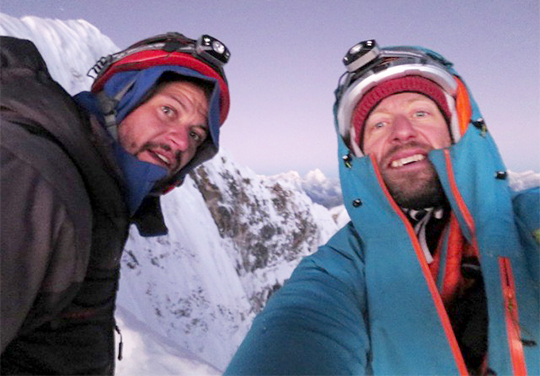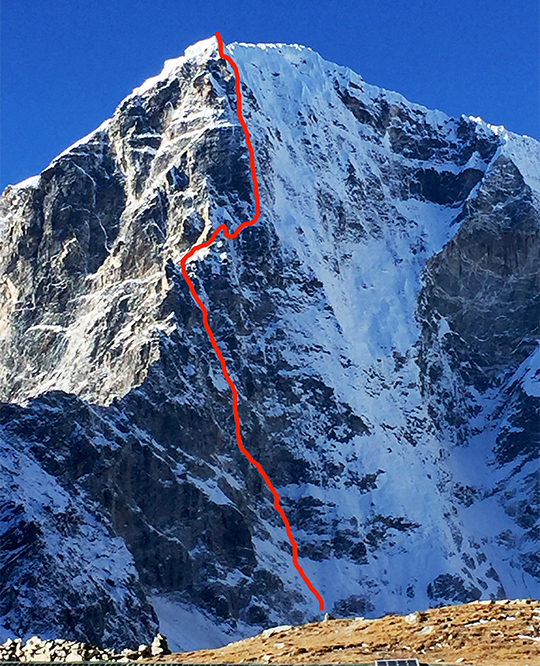
[Photo] Skiy DeTray
On November 14 at approximately 1:30 p.m., Justin Griffin slipped and fell 100 meters to his death while descending from the summit plateau of Taboche (6541m; also called Tawoche) in Nepal’s Khumbu Himal region. Griffin, a husband and father, and Skiy DeTray, a former Pararescueman with the U.S. Air Force, had just completed a new route up the demanding peak’s North Buttress over five days. Below is DeTray’s account of the expedition.
On October 18 we departed the U.S. for Nepal with two goals. The first was to volunteer with the Alex Lowe Charitable Foundation, continuing the construction of the Khumbu Climbing Center in Phortse, which facilitates training of Nepalis in climbing and rescue skills. The second was a hard climbing objective on Taboche.

[Photo] Skiy DeTray
Phortse, a lush village at about 4000 meters, is close to the route leading to Mt. Everest. Yak bells ring in the village while prayer flags decorate the Himalayan skyline. This volunteer opportunity proved a great chance to acclimate for our second goal.
After spending two weeks working with Justin performing construction work at the Khumbu Climbing Center, we trekked toward the remote village of Thugla on November 5. Two days later Justin and I stood in our base camp at the foot of Taboche’s 1524-meter face. We planned to attempt a new route up the unclimbed North Buttress of the mountain. Taboche’s north and east aspects hold some of Nepal’s hardest technical alpine climbing routes with steep ice and mixed terrain. It’s similar in difficulty to the North Face of Mt. Hunter in Alaska, but its higher elevation makes it more difficult.
The mountain was first climbed by its Southeast Face in 1974. Jeff Lowe and John Roskelley climbed the Northeast Face (VII 5.11 M6) in 1989, in alpine style, a ground-breaking ascent at the time. Additional noteworthy ascents include: Mick Fowler and Pat Littlejohn’s 1995 ascent of the Northeast Pillar (ED, 43 pitches), Ueli Steck’s 2005 solo on the East-Southeast Face (M5 60 degrees, 1500m), the Giri-Giri Boys’ 2009 climb of the Direct North Face (AI5 R, 1500m) and Renan Ozturk and Corey Richard’s 2010 ascent of the Central South Buttress (5.10 M4/M5, 1200m). With all the attention the mountain has received over the past 40 years, we were surprised to find that no one had ventured onto the North Buttress.


[Read the NewsWire “Tawoche’s East Ridge Climbed in Winter” from June 22, 2007. Read the NewsWire “Giri-Giri Boys Score FA of Tawoche’s North Face” December 21, 2009–Ed.]
On November 8 we ventured up to take a look at the buttress. We were pleased to find the neve in great shape, the rock solid and the snow settled. The next day under sunny skies and a light breeze we ascended back to our previous high point of 5000 meters and cut a bivy in ice. Spindrift pummeled us all night, even though there was no precipitation. The next day we led five technical M5-6 pitches in a row. Unable to find a bivy site, we fixed a rope and rappelled 70 meters, and spent hours cutting a one-and-a-half-man bivy for our tent.
At this point, I didn’t think we would complete the route–the climbing was slow and the top loomed high above. But we stayed cool and calm and plodded ahead, although our fears and doubts were overwhelming. After climbing more rock and perfect, near-vertical neve, we reached a 700-foot gully. The climbing was not difficult and solid protection was scarce. I surmounted a sugar-snow ridge at midnight and began excavating snow for our precarious bivouac. We made jokes, dreamed of cheeseburgers and reminisced about home.

[Photo] Skiy DeTray
The next morning we were gifted with spectacular views of Everest, Nuptse and Ama Dablam during our only three hours of sunlight while on the North Buttress. We soaked the sunshine up and lounged on our platform until 11 a.m. Four more wildly exposed traversing pitches brought us to a final bivy. Once again we chopped a ledge so narrow that half of my ass hung over the edge. I was terrified all night I would roll off and pull the tent into space. I hugged Justin’s legs like a koala bear. For our final push to the summit Justin suggested that we take a single rope, light rack and little else–this meant no bivy gear. Our plan was to retrieve the stashed equipment during the descent. I didn’t argue. This final day on the route was spectacular–immense exposure and steep granite. It was the best alpine climbing of my life. I led a steep pitch of AI5, M5R at 6100 meters with more than 1200 meters of exposure below my feet. Collectively, we had forty years of climbing experience between us and were having fun. We climbed with confidence and joy.
As the cold shadows of day turned to night, we started to feel fatigued and restless to get to the top. While climbing, the temps were not bad, but by the end of our belay sessions we shook with cold. Justin, in the last six hours of the climb, found hidden gear behind folds of rock and kept volunteering to lead. His strength and courage were commendable. Justin kept saying, “We’re doing it!” We are establishing a hard new route in the Himalaya. It felt good to be so close to our long-time goal.
At 6 a.m. on November 14 we crested the North Buttress onto the summit plateau. The sun shined, the sky was blue and there was no wind. After topping the technical difficulties, we failed to realize the true summit of Taboche was another twelve-hour slog up crevasse-riddled avalanche slopes. Justin and I looked at each other and knew our climb was over.

[Photo] Skiy DeTray
We descended unroped most of the way down the peak’s East Face gully. We laughed and joked and made plans to drink all the beer in the Thugla Lodge and eat french fries by the pound. Justin was excited to call his wife Laura and tell her the news of our success.
We were both tired and our ice axes were worn to a nub from all the dry tooling. Then, less than 100 meters from taking our harnesses off, I saw Justin turn around to downclimb an easy Grade 2, bullet-hard, slippery ice step. He lost his footing and was gone.
Once I located Justin, I performed CPR, but could not revive him. I descended the rest of the mountain alone.
As I sit here now with numb fingertips and toes I can’t help but question why we climb mountains. Is the experience worth the loss of life? The answer I found is simple. Climbing mountains is a way of life, a way to express our physical abilities and to face fear, doubt and insecurities.
I will never again rope up with my good friend Justin Griffin. Justin was far more than just a phenomenal climber. He was also a great family man. He did a fantastic job balancing his love for the mountains with his love for his wife Laura and young daughter Alice. Justin, like many great athletes, possessed an intense burning desire to be great, to push himself to his limits and find the edge of what is possible.

[Photo] Skiy DeTray